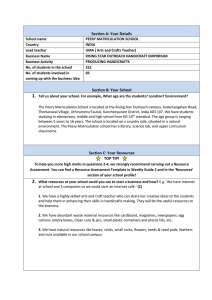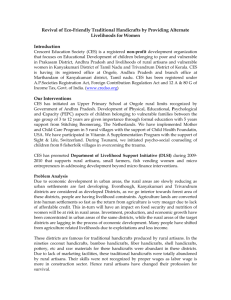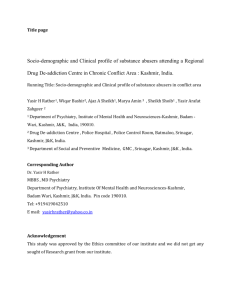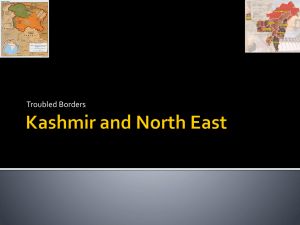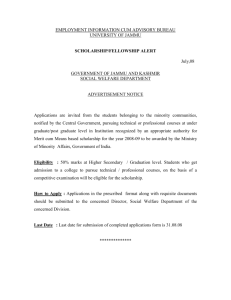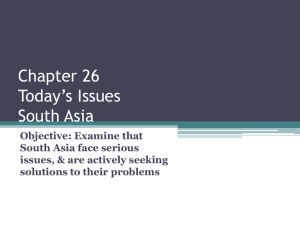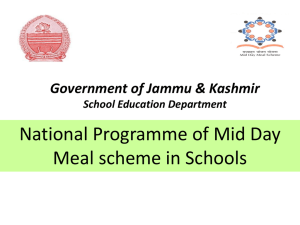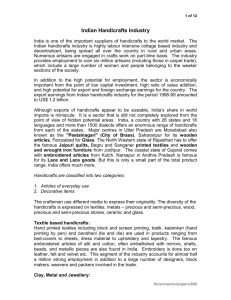1469778575Role of Handicraft in Jammu and Kashmir
advertisement
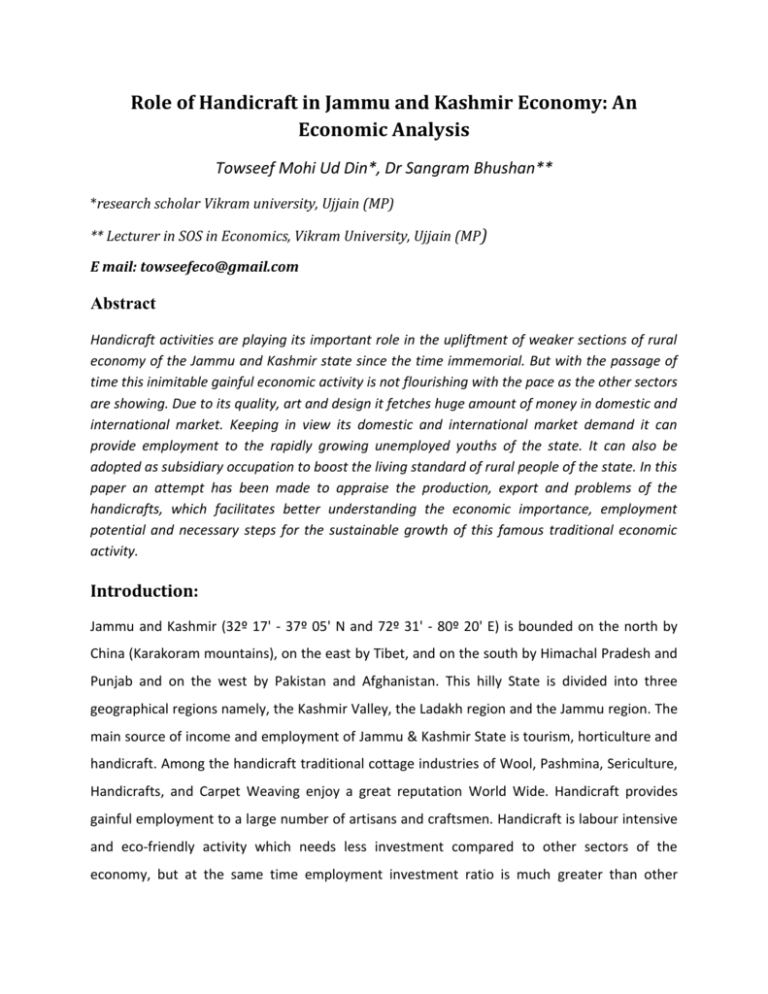
Role of Handicraft in Jammu and Kashmir Economy: An Economic Analysis Towseef Mohi Ud Din*, Dr Sangram Bhushan** *research scholar Vikram university, Ujjain (MP) ** Lecturer in SOS in Economics, Vikram University, Ujjain (MP) E mail: towseefeco@gmail.com Abstract Handicraft activities are playing its important role in the upliftment of weaker sections of rural economy of the Jammu and Kashmir state since the time immemorial. But with the passage of time this inimitable gainful economic activity is not flourishing with the pace as the other sectors are showing. Due to its quality, art and design it fetches huge amount of money in domestic and international market. Keeping in view its domestic and international market demand it can provide employment to the rapidly growing unemployed youths of the state. It can also be adopted as subsidiary occupation to boost the living standard of rural people of the state. In this paper an attempt has been made to appraise the production, export and problems of the handicrafts, which facilitates better understanding the economic importance, employment potential and necessary steps for the sustainable growth of this famous traditional economic activity. Introduction: Jammu and Kashmir (32º 17' - 37º 05' N and 72º 31' - 80º 20' E) is bounded on the north by China (Karakoram mountains), on the east by Tibet, and on the south by Himachal Pradesh and Punjab and on the west by Pakistan and Afghanistan. This hilly State is divided into three geographical regions namely, the Kashmir Valley, the Ladakh region and the Jammu region. The main source of income and employment of Jammu & Kashmir State is tourism, horticulture and handicraft. Among the handicraft traditional cottage industries of Wool, Pashmina, Sericulture, Handicrafts, and Carpet Weaving enjoy a great reputation World Wide. Handicraft provides gainful employment to a large number of artisans and craftsmen. Handicraft is labour intensive and eco-friendly activity which needs less investment compared to other sectors of the economy, but at the same time employment investment ratio is much greater than other sectors. It is also an important source of income for seasonal agricultural labour force. It acts as an instrument in increasing the living standard of rural people. But due to absence of organized market infrastructure and huge exploitation of intermediaries this sector doesn’t show any remarkable growth like other sectors. Objectives: To find out the role of handicraft industry in providing employment to rural economy. To analyses the employment generation potential of handicraft industry. To find out the present problems of handicraft industry and also their possible salutation. Research methodology: The present study is theoretical in nature. The motive behind the present study is the eminent prospects of Jammu and Kashmir handicraft sector in contributing towards economic development of the state. The data for the present study has been collected from secondary sources includes books, journals, newspapers, published and unpublished research work, various search engines, etc. The up to date quantitative data has been collected from the official websites of the Indian handicraft industry as well as J&K handicrafts. The simple regression model has been used: Y = α + βx ………………………………… (1) Y = dependent variable; X = independent variable; α= intercept coefficient and β is the slope coefficient. The value of ‘α’ and ‘β’ is found by the following normal equations. ΣY = Nα + βΣX ………………………….. (2) ΣXY = αΣX + βΣX2…………………….... (3) Results and discussions: The industrial base of Jammu and Kashmir is weak due to many reasons like geographical location and environmental factors. These factors are the main obstacles for investors in the establishment of large manufacturing industries. It is because of this, the industrial base of the state mainly consists of hosiery and basic metal products, wood craft and other handicraft product industries, which contribute a major percentage of total industrial output in the registered manufacturing sector. According to Industrial Statistics of Jammu and Kashmir, 200001 there were 42,808 industrial estates in the state in the medium and small-sector with an employment of 1, 87,399. Handicraft is one of the gainful economic activities which absorb a remarkable amount of labour force from different age groups irrespective of gender. But with the passage of time this important economic activity does not show any outstanding growth rate in its production. The main reason behind the slow growth rate is the use of traditional techniques, non availability of timely and adequate government financial support and exploitation of artisans by middleman. The people of the valley have developed their technical and artistic traditions over centuries in fact; art of the valley is the heritage, which reflects people’s culture through the ages. To maintain the world reputation of this famous cultural heritage activity, Government should allocate adequate amount of financial support. Government should provide incentives for the introduction of modern sophisticated technology at various stages in the processing of handicraft items. It will help handicraft industry from the stiff competition, which it is facing from many neighboring countries. The importance of this sector lies in the fact that it has enormous employment potential; it does not consume scarce resources, does not cause pollution and is environment friendly. The social cost benefit ratio is very small therefore both private and public sector should make investment in this sector so that it will grow up manifold. J&K is famous for the weaving of specialized fabrics like Pashmina and kani shawls, silken, woolen and cotton fabrics. The three regions of the state – Jammu, Kashmir and Ladakh – specialize in different crafts. The main crafts of the three regions are: 1. Jammu – Basholi Painting, Calico Painting, Phoolkari. 2. Kashmir – Carpets, Kashmiri Shawls, Wood Carving, Papier-mache, Chainstitch, Crewel, Namda. 3. Ladakh – Wood carving & Painting, Clay Moulding, Ladakh Pashmina Weaving, Ladakh Carpet, Thanka and Fresha Painting. Keeping in view the importance of this labour intensive and eco friendly sector of the cottage industry state has established the Jammu & Kashmir Handicrafts Sales & Export Promotion Corporation and J&K State Handloom Development Corporation to promote development and growth of the handicrafts sector. Table No 1.1 Year production of various handicrafts Carpet (in crores) Woolen Papier Other shawls machie items Total production 2003-04 450.53 275.00 13.50 82.50 821.53 2004-05 425.00 315.00 24.00 123.00 887.00 2005-06 425.00 310.00 30.00 135.00 900.00 2006-07 450.50 320.00 35.00 144.50 950.00 2007-08 761.27 420.58 37.92 394.82 1614.59 2008-09 457.60 303.45 35.49 303.46 1100.00 2009-10 638.17 201.03 10.15 151.15 1000.00 2010-11 735.10 343.10 68.82 502.28 1650.30 2011-12 624.70 702.20 102.70 385.73 1815.33 38.7 5.7 21.2 100.00 19.4% 11.2% 45.9% 15.1% %age composition 34.4 of handicraft production Average annual 4.8% growth rate Simple Regression Model: Y = α+ βx+ ui Where, Y = production X = time period Ui = error term Model Summary Adjusted R Model R .781a 1 R Square .610 Square Std. Error of the Estimate .554 258.36073 a. Predictors: (Constant), VAR00002 Coefficientsa Standardized Unstandardized Coefficients Model 1 B Coefficients Std. Error (Constant) 641.936 187.695 VAR00002 110.252 33.354 Beta t .781 Sig. 3.420 .011 3.305 .013 a. Dependent Variable: VAR00001 The coefficient of determination (R2) of the above fitted regression model showed 61% of the variance of the dependent variable was explained by the independent variable. It may be concluded from above both tables that tcal is greater than ttab so we reject the null hypothesis and concluded that there is significant relationship between production and time period of handicrafts both at 1% and 5% level of significance. Table No. 1.2 year wise production of handicrafts and their trend value Year 2003-04 production 821.53 Y=641.93+110.25x 2004-05 887.00 862.43 2005-06 900.00 972.68 2006-07 950.00 1082.93 752.18 2007-08 1614.59 1193.18 2008-09 1100.00 1303.43 2009-10 1000.00 1413.68 2010-11 1650.30 1523.93 2011-12 1815.33 1634.18 Fig 1.1 producation Chart Title 2000 1800 1600 1400 1200 1000 800 600 400 200 0 production Y=641.93+110.25x time Table No. 1.3 Year Exports of various handicrafts carpet Woolen Papier shawls machie (in crores) Other items Total export 2003-04 2004-05 334.00 307.50 196.00 210.00 10.50 17.50 54.50 107.00 595.00 642.00 2005-06 325.00 220.00 27.50 132.50 705.00 2006-07 351.50 275.00 31.50 127.00 785.00 2007-08 649.02 310.29 33.65 207.51 1200.47 2008-09 326.00 226.50 41.00 112.00 705.50 2009-10 407.73 137.13 30.27 86.14 661.27 2010-11 412.45 302.00 66.50 223.15 1004.10 2011-12 567.13 607.03 98.24 370.97 1643.37 Simple Regression Model: Y = α+ βx+ ui Where, Y = exports X = time period Ui = error term Model Summary Adjusted R Model R R Square .675a 1 Square .455 Std. Error of the Estimate .378 272.79326 a. Predictors: (Constant), y Coefficientsa Standardized Unstandardized Coefficients Model 1 B (Constant) y Std. Error 456.344 198.180 85.214 35.217 Coefficients Beta t .675 Sig. 2.303 .055 2.420 .046 a. Dependent Variable: x The coefficient of determination (R2) of the above fitted regression model showed 45% of the variance of the dependent variable was explained by the independent variable. It may be concluded from above both tables that tcal is greater than ttab so we reject the null hypothesis and concluded that there is significant relationship between exports and time period of handicrafts at 5% level of significance. Table No.1.4 year wise exports of handicrafts and their trend value year export 2003-04 2004-05 595.00 642.00 Y=456.34+85.21x 541.55 626.76 2005-06 705.00 711.97 2006-07 785.00 797.18 2007-08 1200.47 882.39 2008-09 705.50 967.6 2009-10 661.27 1052.81 2010-11 1004.10 1138.02 2011-12 1643.37 1223.23 Fig 1.2 1800 1600 1400 exports 1200 1000 800 export 600 Y=456.34+85.21x 400 200 0 time Problems: One of the important constraints for the growth of handicraft sector is the lack of organized market sector, as no attention is paid towards this aspect, which performs leading role in the sustainable growth of any sector. Inefficient skilled labour is another challenge to this world famous our state. Inadequate power supply and raw material which is the pre-request for this handicraft is one of the burning problem of this sector. Restrictive adaptation of the modern sophisticated technology is an obstacle in improving the quality of handicrafts, the use of which is necessary to reduce the cost of production and with stand the world competition. Timely and adequate financial assistance to the artisans is another necessary activity for the increasing the production and productivity of handicrafts. Major steps taken by government for handicrafts: Office of the Development Commissioner (Handicrafts) under Ministry of Textiles organizes various Market Promotional activities all over the country for extending Marketing Support to the Artisans and to develop the sector as a whole. During 2010-11, 260 Marketing events were planned to be organized. Under development of infrastructure scheme a Permanent Marketing Platform has been created at SHILPI HAAT at Rajiv Gandhi Handicrafts Bhawan, Baba Kharag Singh Marg, New Delhi which contains 50 stalls for display/sale of craft products. These are allotted to artisans on rotation basis. A Thematic Exhibition named “Kashmir Handicrafts Expo” (Nayab) has also been organized from 6th to 18th December, 2010. 50 artisans/exporters from Jammu & Kashmir State representing various Handicrafts displayed their produces for sale among public. J&K Small Scale Industries Development Corporation Limited (SICOP) was established in 1975 as a wholly owned company of the Government of J&K. It has been entrusted with a variety of roles for the development of small-scale industries (SSI) in the state. Suggestions: For the sustainable growth of the handicraft industry advertisement both at national and international level should be undertaken publicity, exhibition, printing of brochures and participation in fairs will help in boosting this traditional industry. Government should set up well organized handicraft marketing system so that both producers and consumers would reap more and more benefits. In the absence of well organized market both consumers and producers are exploited. Government should exempt or at least the sales tax on handicrafts which will result in the price of handicraft products and thereby increase the sales. Foreign master designers may be invented to design centers to render guidance to the craftsman. Uniformity in price is also an important tool for the growth of this industry. The customers feel that they were exploited and get harassed when they purchase the same handicraft product from two shops at different prices. Conclusion: Handicrafts are the matchless appearance of our society and way of life. A hefty crowd of population is directly or indirectly depends upon handicrafts for their livelihood. It generates employment and foreign exchange earnings which are vital for economic growth and upliftment of the rural economy. The dynamic factors which determine the growth and decline of craft need to be understood from a total livelihood perspective and not a narrow economic perspective alone. In order to optimal exploration of this handmade industry Government should provide both incentives and assistance. Both state and central Government must take step to increase the wages and improve the working conditions of the artisans and others who are involved in this handmade industry. References 1. Government of Jammu and Kashmir, Digest of statistics, Directorate of Economics & Statistical Planning, Srinagar , (2011) 2. Dak, T.M., Rural Industrialization: Challenges and Responses, North Book, Delhi (1989) 3. Mehta, R.J.: The Handicrafts and Industrial Arts of India. Taraporevala, Bombay, (1960) 4. Florence, K., Uganda Handicrafts Export Strategy, ITC Report, WTO (2005) 5. Bhandari, Dhingra, Dr. Vandana, Sudha .Textiles and Crafts of India. New Delhi: Prakash Book Depot (1998) 6. Jena, P.K.: Globalization and Indian Handicrafts : Quest for a Gandhain Way. Gandhi Maarg, (2008) 7. Vellani, Anmol. "Sustaining Crafts Development in India". India Foundation for the Arts, (2011) 8. Omera, Jan. The Handicraft Industry of J&K. Unpublished M.Phil. Dissertation at the University of Kashmir, (1990) 9. Government of India: Economic Survey, Minister of Finance, New Delhi(2007-2008) 10. Sited in the Annual Report of Export Promotion Council for Handicrafts, New Delhi, (2006-07) 11. Vazith, Hussain. Small scale industries in the New Millennium. New Delhi, (2003)
